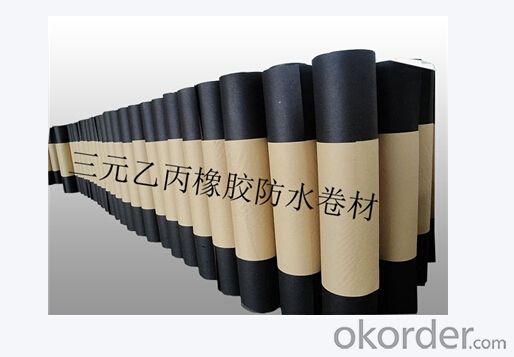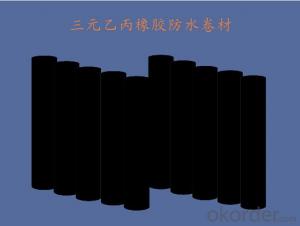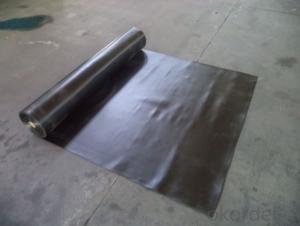Roof EPDM Waterproofing Membrane
- Loading Port:
- China Main Port
- Payment Terms:
- TT OR LC
- Min Order Qty:
- -
- Supply Capability:
- -
OKorder Service Pledge
OKorder Financial Service
You Might Also Like
EPDM waterproofing membrane
1. Brief Introduction:
It is a kind of self-adhesive waterproof coiled material based on polymer rubber and superior asphalt, together with polyethylene film and aluminum foil as surface material or no film(Double-sided self-adhesive). And it adopts the package preventing-adhesion-isolation-layer package, and dividing into no fiber and polyester fiber two parts.The coiled material has perfect performances, simple operation, non-pollution and etc.
2. Characters:
1)Good flexibility, creep properties and malleability, and the superior adapting ability to the deformation of the primary stress generated.
2). Tight adhesion between waterproof layer and basic layer, no channeling water. Having self healing ability after piercing.
3).Operation without heating. And possessing the reliability of pasting by itself with super strong connection of sheet materialand adhesion of same base.
4). Convenient and safe operation, no pollution to the environment.
3. Application:
Widely applied in roofing, basement, tunnel, railway and subway and waterproofing projects. And also used for other waterproof projects as wooden and metal structural surface.
4. Package and Storage:
Each Roll with one plastic bag with or without pallets.
Keep in dry and ventilated place. Avoid shining and raining. Height of stack not more than 5 layers. Shelf life:12 months.
5. Specification:
Type | EPDM Waterproof Rubber Membrane | |||
Material | EPDM Rubber | |||
Thickness | 1.0mm | 1.2mm | 1.5mm | 2.0mm |
Size | 1.2m(width) * 20m(length)/roll | |||
Type | Vulcanized | |||
Pattern | Non-reinforced(homogeneous) | |||
Packing | 24sqm--80sqm/roll, with plastic bag | |||
Color | Black | |||
Application | Roofs, basement, pond, Lake, steel structure roof, swimming pool, underground, tunnel, etc | |||
5. Some photos:



- Q:Can a waterproofing membrane be removed or replaced if necessary?
- Yes, a waterproofing membrane can be removed or replaced if necessary. Over time, waterproofing membranes can deteriorate or be damaged, leading to leaks or moisture penetration. In such cases, it is necessary to remove the existing membrane and replace it with a new one to ensure proper waterproofing. The process of removal and replacement involves carefully stripping off the old membrane, cleaning the surface, and applying a new membrane system. It is important to consult with a professional waterproofing contractor who can assess the condition of the existing membrane and provide appropriate recommendations for removal and replacement.
- Q:Can a waterproofing membrane be applied on both horizontal and vertical surfaces?
- Yes, a waterproofing membrane can be applied on both horizontal and vertical surfaces. Waterproofing membranes are designed to create a protective barrier against water penetration and can be effectively used on various surfaces, including both horizontal surfaces like roofs and decks, as well as vertical surfaces such as walls and foundations.
- Q:Is a waterproofing membrane environmentally friendly?
- Yes, a waterproofing membrane can be environmentally friendly. Many modern waterproofing membranes are made from sustainable materials, such as recycled rubber or PVC-free compounds. Additionally, some membranes are designed to be easily recyclable at the end of their lifespan, reducing waste. Furthermore, a properly installed and maintained waterproofing membrane can help prevent water damage and mold growth, leading to a healthier and more sustainable environment.
- Q:Can a waterproofing membrane be used for water treatment plants?
- Yes, a waterproofing membrane can be used for water treatment plants. Waterproofing membranes are designed to prevent the passage of water and can be used to provide a barrier against water leakage in various structures, including water treatment plants. These membranes can be applied to different areas of the plant, such as tanks, reservoirs, pipes, and basements, to prevent water infiltration and protect the infrastructure from potential damage. Additionally, waterproofing membranes can help maintain the integrity of the water treatment process by ensuring that water remains contained within designated areas and does not seep into surrounding soil or structures.
- Q:Can a waterproofing membrane be used for an industrial facility floor?
- Yes, a waterproofing membrane can be used for an industrial facility floor. Waterproofing membranes are commonly used in industrial settings to protect floors from water damage and to prevent moisture from seeping into the concrete or substrate. These membranes are designed to create a seamless and impermeable barrier that can withstand heavy foot traffic, industrial equipment, and chemical spills. They can also provide additional benefits such as resistance to mold and mildew growth, increased durability, and easier maintenance. However, it is important to choose a waterproofing membrane that is specifically designed for industrial applications and to follow the manufacturer's instructions for proper installation and maintenance.
- Q:Does a waterproofing membrane provide any insulation against heat or cold?
- A waterproofing membrane, in itself, does not offer any insulation against heat or cold. Its primary purpose is to stop water infiltration into the building, but it lacks the ability to regulate temperature. Temperature control is usually accomplished by incorporating separate materials like foam boards, fiberglass, or other thermal barriers alongside the waterproofing membrane. These additional elements provide thermal resistance and regulate temperature.
- Q:What are the proper installation techniques for a waterproofing membrane?
- To ensure effective and long-lasting protection against water infiltration, proper installation techniques for a waterproofing membrane involve a series of steps. Here are some guidelines: 1. Start by preparing the surface. It is crucial to have a clean and smooth substrate. Eliminate any loose debris, dirt, or previous coatings. Before moving forward, make sure to repair any cracks or imperfections in the surface. 2. Enhance adhesion between the substrate and the waterproofing membrane by applying a suitable primer. The primer should be compatible with both the substrate material and the membrane. 3. Select a waterproofing membrane that suits the specific application and site conditions. There are different types available, such as sheet membranes, liquid-applied membranes, and self-adhesive membranes. Consider factors like the substrate material, expected movement or stress, and exposure to chemicals or UV radiation. 4. Install the membrane. The exact method may depend on the type of membrane used, but the following general steps apply to most installations: a. Carefully unroll or unfold the membrane, avoiding wrinkles or folds. b. Position the membrane onto the primed surface, ensuring it extends beyond the desired waterproofed area. c. Firmly press the membrane onto the substrate using a roller or trowel, ensuring good contact and eliminating air pockets. d. Overlap the edges of adjacent membrane sheets or sections according to the manufacturer's instructions, typically around 2-3 inches. e. Seal the overlaps securely by applying a suitable seam or joint adhesive. 5. Perform testing and inspection. After installation, it is essential to conduct a comprehensive quality control check. Conduct a flood or water test to verify the membrane's effectiveness in repelling water and to identify any leaks or defects. 6. Protect and finish the installed membrane. Prevent damage during construction activities and enhance durability and resistance to UV radiation or mechanical stress by applying necessary protection layers or coatings. 7. Maintain and repair. Regularly inspect the waterproofing membrane and promptly address any signs of damage, wear, or deterioration. Follow the manufacturer's guidelines for maintenance and perform necessary repairs as soon as possible to maintain the membrane's effectiveness. It is always advisable to consult with a professional waterproofing contractor or follow manufacturer recommendations for the specific membrane being used, as installation techniques can vary.
- Q:Are waterproofing membranes suitable for residential applications?
- Yes, waterproofing membranes are suitable for residential applications. They are commonly used in various areas of residential construction, such as basements, foundations, roofs, bathrooms, and balconies, to prevent water penetration and protect the building structure from moisture damage. Waterproofing membranes provide a barrier against water, preventing it from seeping into the structure and causing issues like mold, rot, or structural damage. These membranes are typically made of materials like bitumen, PVC, EPDM, or polyurethane, which are highly effective in repelling water. In residential constructions, waterproofing membranes are installed during the building process or as a part of renovation projects. They can be applied as a liquid coating or in the form of sheets that are laid down and adhered to the surface. These membranes create a seamless and durable barrier that can withstand the test of time. Additionally, waterproofing membranes offer various benefits for residential applications. They help maintain a dry and comfortable living environment by preventing water leaks and dampness. This, in turn, protects the integrity of the building materials, prolongs the lifespan of the structure, and reduces the risk of costly repairs. Furthermore, waterproofing membranes can also enhance energy efficiency by reducing moisture-related heat loss or gain. By preventing water infiltration, they help maintain consistent temperatures inside the house, resulting in lower energy consumption and utility bills. Overall, waterproofing membranes are an excellent choice for residential applications. They provide reliable protection against water damage, improve the longevity of the structure, and contribute to a healthier and more energy-efficient living environment.
- Q:Can a waterproofing membrane be used for swimming pool decks?
- Yes, a waterproofing membrane can be used for swimming pool decks. A waterproofing membrane is a protective barrier that prevents water from seeping into the underlying structure. It is commonly used in areas where water exposure is high, such as swimming pool decks, to ensure the longevity and durability of the structure. The membrane is typically applied over the concrete surface of the pool deck and provides a seamless, watertight seal. This helps to prevent water damage, such as cracking, spalling, or deterioration of the concrete, and minimizes the risk of leaks or water seepage into the surrounding areas. Additionally, a waterproofing membrane can also provide added benefits such as slip resistance, UV resistance, and protection against chemicals and stains. It is important to choose a high-quality waterproofing membrane that is specifically designed for swimming pool decks and can withstand frequent exposure to water and other environmental factors.
- Q:What is the difference between polymer waterproofing membrane and cross film waterproofing membrane?
- The use of high-quality pressure-sensitive adhesive adhesive layer, with the concrete base of the rapid combination of its excellent self-healing properties and local self-locking water performance greatly reduce the penetration rate. The polymer in the coil material reacts with the cement compound to form an interpenetrating network structure, which eventually forms a continuous mechanical bond and is permanently sealed on the cementitious material member.
1. Manufacturer Overview |
|
|---|---|
| Location | |
| Year Established | |
| Annual Output Value | |
| Main Markets | |
| Company Certifications | |
2. Manufacturer Certificates |
|
|---|---|
| a) Certification Name | |
| Range | |
| Reference | |
| Validity Period | |
3. Manufacturer Capability |
|
|---|---|
| a)Trade Capacity | |
| Nearest Port | |
| Export Percentage | |
| No.of Employees in Trade Department | |
| Language Spoken: | |
| b)Factory Information | |
| Factory Size: | |
| No. of Production Lines | |
| Contract Manufacturing | |
| Product Price Range | |
Send your message to us
Roof EPDM Waterproofing Membrane
- Loading Port:
- China Main Port
- Payment Terms:
- TT OR LC
- Min Order Qty:
- -
- Supply Capability:
- -
OKorder Service Pledge
OKorder Financial Service
Similar products
New products
Hot products
Hot Searches
Related keywords




























